
Your baby's behavior
States
Your baby is more than just asleep or awake. Your baby has six states or levels of being awake or asleep. You can recognize these states by your baby's behavior.
They are:
- Quiet sleep. During this kind of sleep your baby is still and breathes slowly and deeply. It is hard to wake your baby from this level of sleep. If you need to wake your baby for a feeding, wait until they move to lighter sleep. Your baby is in this level of deep sleep for only about 30 minutes at a time.
- Active sleep. When your baby is at this level of sleep, they may have bursts of sucking, make faces or little sounds, and breathe less evenly than in quiet sleep. You may also see your baby's eyes moving under their eyelids. This activity can make you think your baby is awake. If you don't need to wake your baby, let your baby stay in active sleep. They may drift back into quiet sleep after about 30 to 60 minutes.
- Drowsiness. This is the state between being asleep and awake. Your baby will open and close their eyes, yawn and stretch. Your baby's eyes will look dull and not well focused.
- Quiet alert. This is the state in which your baby is ready to interact with you and the world. This is the time to play with your baby. You can tell the quiet alert state by your baby's quiet body and bright, focused eyes. Your baby will focus all attention on you, especially your face. They may imitate your expressions and even reach out to touch your face. Newborns can stay focused like this for only a few minutes at a time.
- Active alert. In this state your baby becomes more physically active and less focused than in the quiet alert state. Your baby may also start to fuss. This is a sign that your baby needs a change. It can mean that your baby is getting tired or that they are getting hungry. In only a few weeks you will figure out when your baby starts to fuss what will help calm your baby. You will learn this by trying different things and finding what works best.
- Crying. This is the state your baby uses to let you know they need something. This state can follow the active alert or active sleep states. Picking up your baby may be enough to stop their crying. Many times babies cry because they are hungry. However, crying is a late sign of hunger. Learn more about earlier signs of hunger.
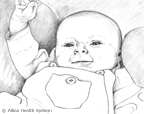 |
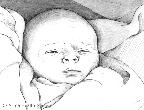 |
|
Alert |
Drowsy |
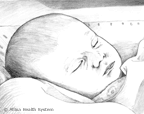 |
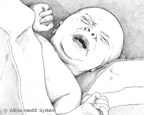 |
|
Sleeping |
Fussy |
It is normal for you baby’s sleep patterns to change often over the first few weeks. Sleep may occur in short bursts of time. Your baby may sleep a lot during the day and be awake at night. This can be challenging for new parents. Try to sleep when your baby sleeps or ask someone else to take care of your baby so that you can nap. Before you know it, you and your baby will settle into a comfortable routine.
Temperament
Temperament describes how a person responds to the world. You will see some aspects of your baby's temperament right from birth. Others will unfold as your baby grows. Some babies have a sunny temperament and move smoothly between states. Other babies are more easily overwhelmed and find it hard to settle.
As you learn how your baby responds to situations, you will adjust how you provide care. You will soon discover how your baby likes to be carried and what kind of rocking is soothing.
If you already have a child, you may be amazed by how different your new baby's temperament is. This baby may feed more eagerly or need more holding before falling asleep. You will spend time in the first weeks after birth learning how to best take care of this baby.
It is common for babies to sleep a lot the first two or three days after they are born. They take this time to recover from the stresses of birth. This sleepiness can hide some aspects of temperament.
Attachment is the process where the baby has learned to trust the parent(s) through consistent, predictable, nurturing care. Most parents say that taking care of their baby helps them feel closer to their baby. You can't spoil your baby with love and attention.
Talk with your baby's health care provider about any questions or concerns you have about responding to your baby.
You may be surprised by how noisy your baby can be. Your baby will:
- sneeze, which helps clear their nose
- hiccup, which often happens after eating or too much stimulation
- breathe noisily, which is not a concern unless their skin turns blue
- gag, burp and pass gas
How to get off to a good start
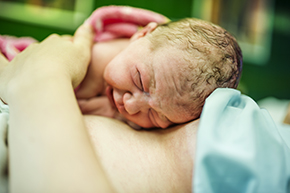
Skin-to-skin contact is when your baby is placed naked against your or another caregiver's bare skin. (Your baby may have a hat and diaper.)
Cuddling skin-to-skin with your baby
The first hour with your baby is a special time.
The American Academy of Pediatrics recommends the first hour of a baby's life is spent with uninterrupted skin-to-skin contact. Skin-to-skin can be done after a vaginal or Cesarean birth.
Cuddling skin-to-skin has many benefits:
- encourages breastfeeding
- helps regulate your baby's temperature and blood glucose
- helps create an emotional bond
- keeps baby warm
- reduces crying
Routine medical care can be done while your baby cuddles with you. Some care can wait and be done at a later time.
Your support person can hold and bond with your baby skin-to-skin too. It is a wonderful way to be a special part of your new baby's life.
You are encouraged to hold your baby skin to skin as often as you can in the first hours and weeks to come.
Watch your baby's feeding cues
Your baby will give you cues when they are hungry:
- roots or turns head when cheek is stroked
- opens mouth and searches
- smacks lips
- makes sucking movements
- puts hand in mouth
- moves body in a way that looks like squirming
- cries (the last cue)
Having your baby stay in your room will make it easier to watch for the feeding cues.